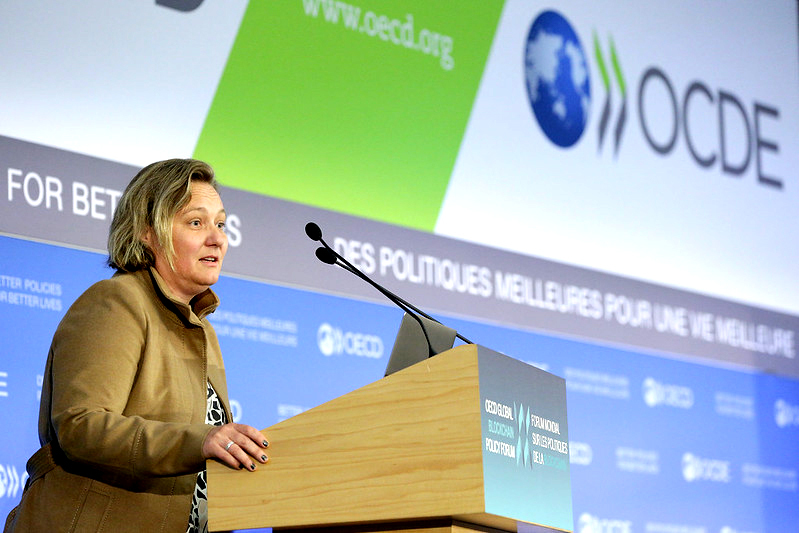Wine counterfeiting is nothing new. Throughout human history, wine vessels have been forged, spiked, relabelled and watered down, despite the close attention of growers and collectors. Blockchain wine and intelligent labelling means wine drinkers can be more confident than ever before that their favourite drop is the real deal.
As soon as there is a market for good quality or rare wine, nefarious huxters look for an opportunity to introduce cheap substitutes. When a tiny invasive aphid nearly wiped out the whole of France’s vineyards 150 years ago, the shortfall of prised wines from prestigious châteaux gave way to an influx of lesser quality imports. Counterfeiting grew so rampant that producers looked to protect their reputations with the system of Appellation d’Origine Contrôlée, a certifier of origin in France with other like-minded organisations globally that verify wine today.
Yet, given the nature and complexity of wine, the odds of success are still with the crooks. An opened bottle will immediately lose its value, so testing the contents is undesirable. Even then, how many connoisseurs will recognise a genuine vintage from a similar non-vintage that has been improved with a young wine and then relabelled? Experts have estimated that at least a fifth of bottles sold at auction are dubious, taking the global worth of the counterfeit ‘industry’ to as much as $3billion.
While fine wines attract the headlines, the main flow in money is around high-volume mass-market imports of foreign luxury goods into Asia. According to a leaked report by the watchdog National Committee of French Foreign Trade Advisors (CNCCEF), every second bottle of French wine sold in China is counterfeit. Scotch whisky faces a similar challenge across the region, with empty bottles filled with flavoured vodka and then resealed. Such is the skill of the forgers around imposter packaging that even experts are often duped until they take the cap off at least. Worldwide, nearly a third of all alcoholic drinks are mislabelled, counterfeit or fake, according to the International Center for Alcohol Policies.
Winegrowers large and small bear the greatest responsibility in upholding their brand, yet they also have the least amount of visibility into their supply chain. When the barrels or bottles leave their gates, there is only so much that winegrowers can do to protect their legitimacy. Brands can find themselves helpless when confronted with unscrupulous and sophisticated fraudsters. When wine or spirits are adulterated or falsely labelled, reputations built on craft, origin, and quality are quickly tarnished. Lack of transparency throughout the wine and spirits supply chains leaves them vulnerable to counterfeiting, impacting consumer confidence and restricting brand equity.
Most genuine bottle must pass a strict geographical certification procedures or audit before it can establish its authenticity on the shelf. Therefore, if this audit information can be immutably recorded on a digital ledger that’s made readily available to traders, collectors and buyers, the risk of counterfeit can be minimised. In addition, brands can market the undisputed authenticity of their wines.
That’s where blockchain can come into the story. A combination of emerging technologies can help wine producers create a unique digital identity for every bottle, using technologies like blockchain, near-field communication (NFC) and Internet of Things (IoT) technology. This involves technology vendors and experts working closely with customers all along the supply chain, from growers to vinters and into broader retail, all with the goal of building ever more authenticity in the global industry.
Until now, authenticators could only identify a counterfeit and were unable to certify an authentic bottle, save for referencing a certificate of authenticity. But that piece of paper is susceptible to tampering and forgery, and its to remain connected with the bottle of wine as it changes ownership and location is unreliable. Solutions like this can facilitate the certification process for appellation and variety designation by converging and surfacing the story of every bottle. Each bottle has its ownership registered on out private blockchain. Every transaction can therefore be securely recorded, from vineyard to table.

For wine, a bottle’s identity (or ‘digital twin)’ is accessible by interacting with its NFC chip by a tap from one’s smartphone. That digital twin of the bottle travels with the wine between stakeholders and records are updated as the bottle changes hands. At every stage of the journey, organisations can link to the bottle’s digital twin to verify its legitimacy.
As all interactions with a bottle are recorded on the blockchain, the gains for authentication over a secure website are substantial. Simply using websites to verify origin has proved inadequate when faced with organised criminals. Anyone who has ever been tricked by a phishing scheme will have seen a phoney website purporting to be a trusted brand. The sad truth is that faking a site is easy. Similarly, a QR code from a genuine bottle can also be reprinted and applied on a replica.
This is a real game-changer for the industry. The adoption of intelligent labels and anti-tamper smart closures, with chain-of-custody events on any given bottle made visible to all on the ledger, is making business a lot more difficult for fraudsters.
Blockchain enabled providence offers more than just protection of legitimacy. For many forward-looking brands, the value of blockchain lies in the ability to share the information that their customers most want to know – in a verifiable and secure way. They want to consolidate a consensus of events, from all the people and places that make a bottle distinct. These can be certifications of sustainable harvest methods, updates on rarity, or a virtual tasting room experience!
Evidencing an authentic back-story resonates with consumers who seek to understand the lifetime journey of their preferred products. The ability to scan a bottle and see its unique story of provenance, told by the grower, the vintner and the regional certifier is quite different than conventional ad copy and marketing campaigns. It gets to the truth in a way that a new generation of customers appreciate.
While consumer engagement is where much of the technologies application may centre at first, these type of solutions will ultimately simplify an otherwise unclear path to market for producers, whose products face an enormous amount of regulations, a myriad of different compliance standards, and the threat of ending up in grey markets. Assume a brand wants to ensure its bottles’ origin can be certified, their temperature and condition verified in transport, and their authorised distribution guaranteed. All of this can be achieved through a mix of IoT enablement around the packaging (RFID, NFC, sensors or machine vision) and recorded for all in the grape-to-table supply chain to see. With smart-contracts (a kind protocol to enforce agreements that only blockchain can provide), payment transactions are sent automatically and directly peer-to-peer when all of the origin, conditions and chain-of-custody criteria are met.
From small family wineries and craft distillers to large conglomerates whose portfolio maintains a global reach, blockchain can provide unprecedented consumer engagement, authenticity and security around individual bottles and in diverse markets.
Emerging technologies have the power to automate compliance, authentication and payments to preserve traditional brand reputations, as well as open up the global marketplace to new entrants. That’s worth raising a glass to.
First Published by the IT ProPortal.










